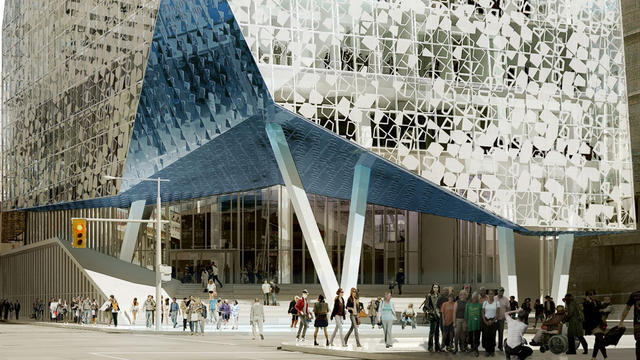New Brampton University Set to Attract More Aboriginal and War Veteran Students
Published March 23, 2017 at 8:12 pm

While a new university is always good news for a city and its residents, its incoming presence is even more exciting when leaders announce that the institution will do its best to attract two under
While a new university is always good news for a city and its residents, its incoming presence is even more exciting when leaders announce that the institution will do its best to attract two underrepresented classes of students: Aboriginal people and war veterans.
While there’s often a great deal of talk about post-war recovery and Aboriginal rights, it’s slightly rarer to see bona fide action behind the hand wringing and well-meaning sentiments.
As almost everyone surely knows, Ryerson has expressed formal interest in becoming Brampton’s university partner. The downtown Toronto institution will partner with Sheridan College to provide local and non-local students with a forward-thinking and innovative STEAM (science, technology, engineering, arts and mathematics) focused institution.
While it’s much too soon to say how the partnership will pan out and what programs will be offered (a location for the upcoming institution has not yet been selected), it does appear that Brampton Mayor Linda Jeffrey is forming connections that will enable the city and university to attract Aboriginal and war veteran students.
“I think some planets and stars have aligned in the last year,” says Jeffrey. “The Lorne Scots [a Peel, Dufferin and Halton infantry regiment with presence in Brampton] unveiled monuments here and we worked with them and I learned how challenging it can be to come home from a tour of duty and come back and have to assimilate to civilian life.”
The plan to attract more veterans is not only a novel one, it’s a positive one. Residents who have completed tours of duty in war zones sometimes suffer from post-traumatic stress and have difficulty re-acclimating to civilian life. According to Statistics Canada, as many as one in six veterans struggle with mental health issues, including major depressive episode, panic disorder, PTSD, generalized anxiety disorder and alcohol abuse or dependence.
If veterans come back with serious or disabling injuries, their challenges are more pronounced.
Although it’s not a silver bullet, one way to welcome vets back into society is to give them a few more opportunities to pursue new (and exciting) opportunities.
“Veterans and army reservists struggle to find meaningful, long-term civilian careers. The University can help reservists/veterans assess potential career paths and the related programs of interest through listening groups and one-on-one guidance sessions,” says Daryl Porter, a representative of the Lorne Scots. “It will be vital that the programs optimize the soldier’s existing skill sets. This type of guidance process will need to be developed as the project matures.”
Since it’s challenging for some vets to re-immerse themselves in the day-to-day grind, it’s good to provide prospective students with another option that will allow them to start fresh in a brand new career.
With the university focusing on a range of subjects, Porter is sure programs that suit veterans needs will be available.
“Veterans and army reservists have a wide array of interests and skill sets,” says Porter. “At a high level, programs that allow students to leverage leadership skills would be the ones that they gravitate towards. Business, engineering and even medical related courses stand out.”
The move to attract more Aboriginal students is also a positive one, as post-secondary school rates are slightly lower among First Nations groups compared to the general population. According to Stats Can, data shows that almost one half (48.4 per cent) of First Nations residents had a post-secondary qualification in 2011. Stats Can reports that 14.4 per cent had a trade certificate, 20.6 per cent had a college diploma, 3.5 per cent had university certificate or diploma below the bachelor level and 9.8 per cent had a university degree.
In comparison, almost two-thirds of non-Aboriginal residents aged 25-64 had post-secondary qualifications in 2011. A total of 26.5 per cent of non-Aboriginal residents had university degrees, demonstrating a significant disparity between the two communities.
Because Aboriginal students appear to be underserved by the university community, the city and university partner are working with Algoma University–a school with a strong Aboriginal presence–to attract more local and non-local First Nations students to the school.
“There are some members of the Aboriginal community in Brampton, and many gravitate to Algoma university, which has a presence in Brampton,” says Jeffrey. “I approached Algoma and asked if they’d consider working with our university partner. They’re going terrific work in northern Ontario and they want to grow their footprint in Brampton.”
Although it’s much too soon to say exactly how these partnerships will attract veterans and Aboriginal students to the school, it’s encouraging to see the city jump on the chance to make the academic world a little more welcoming to people typically underserved (and in great need of opportunities).
The initiatives make the news–already so positive–even better.
“It’s a top 10 school for a top 10 city, so in that sense, we’re really pleased,” says Jeffrey. “It’s innovative and it has good bones, good structure and it thinks outside the box.”
We’ll keep you updated on more university news as it becomes available.
insauga's Editorial Standards and Policies advertising





